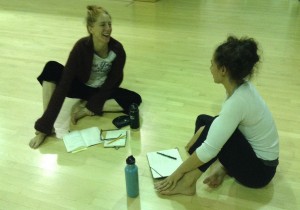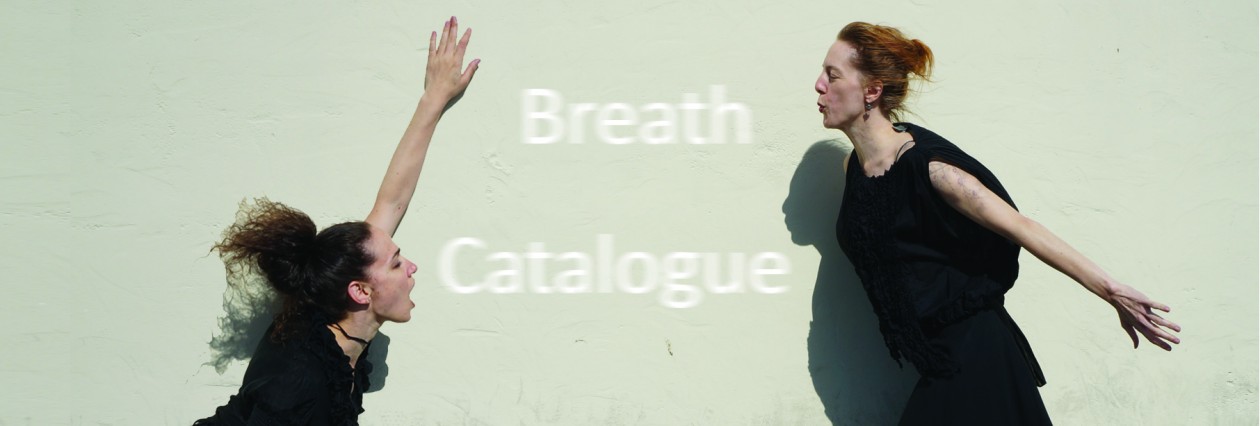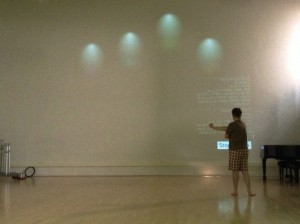(first posted at Spire’s blog)
Breath is one of the primary means through which dancers learn to regulate moving bodies. It allows us to control our own trajectories in time and space, and it is often how we stay connected to others in a group. When I first approached Jonathan about the possibility of using Spire’s prototypes for a new choreography project, this was how I explained it. I told him that I wanted to find out what happened when that thing that is so intrinsic to what we do as dancers—breathing with/in/as motion—is externalized. How, for example, does the relationship between bodies change when breath becomes not only something that passes between two bodies, but something that can be visualized as a kind of third element in the duet? My partner in crime Megan Nicely and I worked together from 2011-12 on The Animation Project, a piece that we showed in San Francisco and London. Returning to the studio together again this summer, we were joined by our technical consultant Ben Gimpert, as well as “Bip” and “Bop” (aka Spire prototypes B11 and B27) and a host of new questions.
We are currently in the research and development phase of the creative process. Our approach has been not to dive straight into “making a piece,” but rather just to begin by exploring what the Spire technology might ask of us as dancers and where it might push us to go that we might not otherwise. We have also brought in concepts of breath from our own physical training, including butoh, forms of yoga, and more traditional modern and jazz idioms.
We made ourselves light-headed a lot, both literally and figuratively. Coming from dance, which relies so much on ideokinesis (changing your body’s muscle patterns through imagery), Megan and I are both trained to think of breathing into the pelvic floor as different from into the upper back, or breathing into the sides of the ribs as different from into the pinkie toe.

While breath certainly shows up in many practices as a way to move beyond the individual self, this summer we have been thinking about how our breathing might materialize something bigger, perhaps even overwhelmingly so, as part of a stage apparatus. Working with sensors Bip and Bop has led us to understand breath as pervasive and durational, as change over time. In order to develop this experience artistically, we have been experimenting with ways to magnify the artifacts that breathing produces, such as sound and the displacement of air, as well as how to use the sensor data we obtain to change our environment and the conditions under which we dance.
More on these later, but a few of the ideas we’ve workshopped include:
- Metronome: Repeat a phrase (a set series of movements). Each time one of us finishes the phrase, pause and take a reading of our breathing rate. That resets a metronome to which we perform. The breathing rate from the previous phrase determines the current one, and our action in the present sets the speed for what we will do in the future.
- Averaging: Set Ben’s working visualizations to show data averaged between the readings taken from Bip and Bop. A game emerges in which we need to neutralize or erase the breath produced by one another’s movement. Another version involves inverting one sensor’s values, so that the goal is a form of unison breath that appears as close to stillness as possible.
- Building a World: Projecting on walls and floor, develop a complex visualization that is either additive or subtractive. The movement is minimal, primarily designed to produce particular forms of breath. Different breathing patterns add (or take away) particular elements of the imagery, ultimately building an immersive installation environment using our breath.
- Looping: Improvisation with leader and follower. The follower wears the sensor, the data from which is projected in real-time on the wall in front of the leader. The information produced by the breath and movement data of the follower determines the leader’s next movements, and thus the follower’s next movements, and thus the visual information that the leader next sees, and so on.
The way I understand it, Spire’s mission is all about helping people to understand the larger story of their breath. In our project, we are starting to take these initial stories as impulses to work in new directions.


